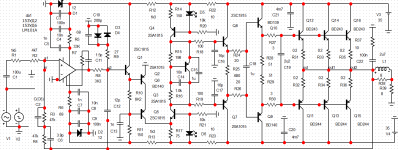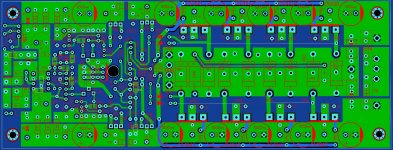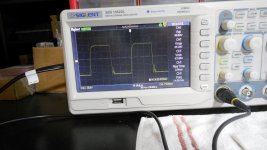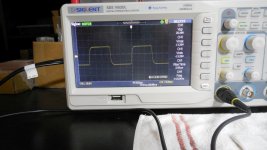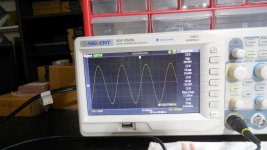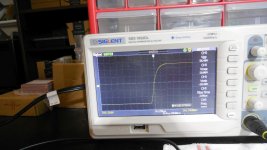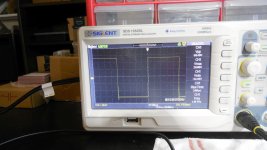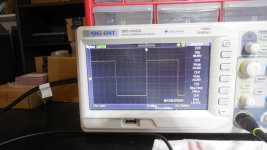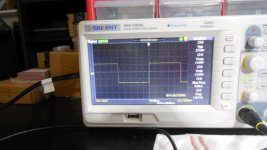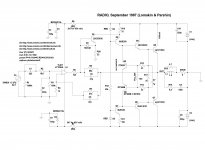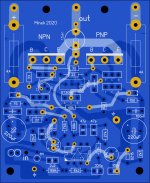After almost 2 days of listening to this amp, I think it gives very nice sound.
Definitely on par (or slightly below) with my "reference" amplifier - Circlophone by Elvee, which I consider (so far) the best sounding amp, of these that I built.
This amp (Lomakin Parshin) is not very complex and it's cheap to build.
Biasing can be simplified, if Si/Ge scheme is abandoned, and replaced by 'traditional' Si Vbe multiplier.
For reference - album with photos:
http://www.slowbears.com/flickr/Lomakin_Parshin/
Next, I'm planning to do more experimentation with the simple hexfet version..
I wonder how it's going to sound.
It sims ok (at least my my eye), waves on the oscilloscope look ok, but let's hear how it sounds...
Definitely on par (or slightly below) with my "reference" amplifier - Circlophone by Elvee, which I consider (so far) the best sounding amp, of these that I built.
This amp (Lomakin Parshin) is not very complex and it's cheap to build.
Biasing can be simplified, if Si/Ge scheme is abandoned, and replaced by 'traditional' Si Vbe multiplier.
For reference - album with photos:
http://www.slowbears.com/flickr/Lomakin_Parshin/
Next, I'm planning to do more experimentation with the simple hexfet version..
I wonder how it's going to sound.
It sims ok (at least my my eye), waves on the oscilloscope look ok, but let's hear how it sounds...
Last edited:
So this one you haven't built yet, right?
The only real differences are:
a) use output triple instead of the double
b) use 3 transistors instead of one at the output of the op-amp. Not sure how to call it?
It's not VAS, I guess "level shifter" ?
I'm assuming you don't have spice sim file for it?
The only real differences are:
a) use output triple instead of the double
b) use 3 transistors instead of one at the output of the op-amp. Not sure how to call it?
It's not VAS, I guess "level shifter" ?
I'm assuming you don't have spice sim file for it?
Last edited:
I can show the MS-12 fileS It's not VAS, I guess "level shifter" ?
I'm assuming you don't have spice sim file for it?
> Build. The signet must be ordered in China.
So you have built a prototype, and now you need to order PCBs
from China, correct?
And the build was working fine?
> Do you know Russian?
I did learn Russian in primary school many years ago, I can understand some, and I should be able to translate easily what I don't understand using google
If you have something in Russian, message me via "Private Messages"
So you have built a prototype, and now you need to order PCBs
from China, correct?
And the build was working fine?
> Do you know Russian?
I did learn Russian in primary school many years ago, I can understand some, and I should be able to translate easily what I don't understand using google
If you have something in Russian, message me via "Private Messages"
https://www.diyaudio.com/forums/attachments/solid-state/797672d1574754339-post-solid-pics-2-jpg
Post 6549
Completed project
Post 6549
Completed project
https://www.diyaudio.com/forums/attachments/solid-state/797672d1574754339-post-solid-pics-2-jpg
Post 6549
Completed project
Appropriately named! "Monster2" !!!
I wonder how Monster1 looked like
Tweaked few component values for the hexFet version, Thd is significantly lower..
I guess it won't hurt. Will try this is in my build tomorrow.
In the sim, these changes also improve BJT version..
Tested these tweaks in the actual build (schematic in post #116)
On oscilloscope everything looks the same or slightly better than before.
Amp very stable. Tested with 40V rails, 50mA per Fet, 8 Ohm resistive load.
So at least I didn't make it worse.
Slew rate seems to be around 17V/us, so it's acceptable.
Next step - listening to the music.
The last photo that shows some oscillations at the bottom of the square, is at 14kHz, 56Vpp.
Vpp is blurred in the photo for some strange reason.. Didn't want to re-do this test, to avoid smoke..
This might be due to lab PSU running out of amps... It tends to trigger oscillations or strange behavior when current limiter kicks in..
Attachments
Last edited:
I'm considering the BJT version as 'completed'.
Here is the final schematic (as built), and PCB SprintLayout file.
D3 and C7 were added after PCB was designed, and both were soldered under the PCB.
Q8 must be in contact with heatsink, and was also soldered under the board.
Tested with rails 35V - 42V.
Q8 can be replaced with MJE 340.
Op-amp: TL071
R6/R7: 0.5W, R15: 2W, R16: 2W, R12: 0.5W
Drivers should have their own small heatsink(s) - Q8 should be tracking temperature of the output devices only.
Here is the final schematic (as built), and PCB SprintLayout file.
D3 and C7 were added after PCB was designed, and both were soldered under the PCB.
Q8 must be in contact with heatsink, and was also soldered under the board.
Tested with rails 35V - 42V.
Q8 can be replaced with MJE 340.
Op-amp: TL071
R6/R7: 0.5W, R15: 2W, R16: 2W, R12: 0.5W
Drivers should have their own small heatsink(s) - Q8 should be tracking temperature of the output devices only.
Attachments
Hard too say 
My subjective experience varies. One day this amp sounds better, another day - another amp
Usually I'm using one of my amps, and after few weeks will get "bored" with the sound, then switch to another amp, and proclaim "This one sounds much better!".
And the whole process repeats itself every month or so.
So I guess I'm trying to say that all of them sound more or less the same.
It's like going to "wine tasting" event. After 3 glasses of different wines, they all taste the same.
But the bottom line - it sounds good. Definitely comparable with AN, and other amps I've built.
My subjective experience varies. One day this amp sounds better, another day - another amp
Usually I'm using one of my amps, and after few weeks will get "bored" with the sound, then switch to another amp, and proclaim "This one sounds much better!".
And the whole process repeats itself every month or so.
So I guess I'm trying to say that all of them sound more or less the same.
It's like going to "wine tasting" event. After 3 glasses of different wines, they all taste the same.
But the bottom line - it sounds good. Definitely comparable with AN, and other amps I've built.
Last edited:
I did listening tests for the hexFet version (simplified version without drivers)
from post #116.
Somehow, I wasn't impressed. True - it's only one channel, and playing on smaller speaker, but my feeling is it didn't sound as good as the BJT version.
I might be wrong though..
from post #116.
Somehow, I wasn't impressed. True - it's only one channel, and playing on smaller speaker, but my feeling is it didn't sound as good as the BJT version.
I might be wrong though..
- Home
- Amplifiers
- Solid State
- Unusual amp from 1987
